CX-30 perfect fit in Mazda’s SUV lineup
By John Gilbert
The unprecedented summer dryspell slowed the streams to a trickle and had the effect of diminishing the usual dramatic change in foliage colors along the North Shore of Lake Superior. That point was driven home to me when I had the chance to test drive a 2021 Mazda CX-30 for a pre-autumn week, and the faintness of the leaves’ color was dramatized by the vividness of the familiar Mazda color of “Crystal Soul Red Metallic.”
Without question, I am a devoted follower of the brilliant technology that has gone into Mazda vehicles, especially in the last couple of decades. While remaining a small player world automotive competition, Mazda turns loose its engineers and designers to ,ake every vehicle a creative endeavor. The result usually is to upgrade the Mazda fleet into world-class vehicles with amazing technology under the skin.
The CX-30 is an example of how Mazda governs itself. The Hiroshima company seemed to have things in order with two sedans — the Mazda3 compact and the Mazda6, a sporty and luxurious intermediate with full-size room — and three SUVs, the CX-3 subcompact, the CX-5 midsize, and the CX-9 near-full-size. with three rows. The CX-5 was just right, with adequate rear seat room and stowage space, and the heart of a performance vehicle.
The CX-3, however, was just plain too small. Only very small children could fit in the rear seat if the front buckets were in normal position, although it might have been the perfect agile SUV for a single driver.
Mazda went back to the drawing board and hustled up its next generation to solve the issue. The plan is to rename those SUVs, with the CX-3 being scratched and replaced by a new vehicle — the CX-30, with significantly more room than the CX-3, but not quite up to CX-5 dimensions. Obviously the plaviouslyn calls for a new CX-5, slightly enlarged to make more room for the CX-30, and it will be called the CX-50, and a new CX-90 will follow to replace the CX-9.
On the car side, Mazda made a controversial decision to eliminate the Mazda6, a car that has earned high marks from critics and fanciers alike.The Mazda3 will now gain more relevance, with slightly enlarged dimensions, and both a sedan and hatchback. The sedan is beautiful, looking like a downsized Mazda6, while the hatchback has an SUV-looking rear end that houses a roomy rear seat — and it now offers all-wheel-drive.
Bt enough of the ancestry. The exterior of the CX-30 has a certain similarity to the family that includes the CX-5 and CX-9, but the contours and lines along the sides blend in that unique and artistic Mazda manner, proving less is more by ignoring the tendency to outline every line with chrome or other trim. The CX-30 has very little trim, and entrusts the gently folding and intersecting contours to come together in a manner that makes it look like it’s going 60 when it’s parked.
If every fold and contour catches all the light, the Crystal Soul Red enhances that technique by looking as though the paint is 6 inches deep. I have said that in my opinion, that color is the most appealing color available on any production car, and while nearly every company has turned its attention to upgrading its color palette, I see no reason to change my opinion.
The bucket seats in the CX-30 are firm and comfortable, worthy of a long trip where you can store driving fatigue in the trunk with your luggage and laundry. There is no place for fatigue inside the cabin. The instruments are straightforward and businesslike, and you can control the alternative settings easily on the console.
The one place I’d take issue is the audio system, where Mazda seems to have given in and joined the industry-wide tendency to make all their audio controls needlessly complex.
OK, if there’s another nuisance it might be that Mazda’s nanny is looking out for us in odd ways. When you ahut it down after a run to Target, you probably shift the lever into “P” for park. When you return and hop into the driver’s seat, you hit the button to fire up the engine, shift into “D” for drive, and go… nowhere. The CX-30, on its own, engages the parking brakek when you shift into park. Now, I have heard suggestions that engaging the parking brake is easier on the transmission than just using park, but I can’t recall the last time anyone i knew wore out their “P” on the shifter.
Still, you get used to pushing the button to escape having the brake on, and once used to it, it would become second nature if you owned the car.
Along those lines of security, if you stop in an unusual parking situation and open the door to make sure you’re within your assigned lines, and you put it in reverse to roll back and perfectly center your car — nope! It won’t let you engage any gear if the door is open. Not a bad safety feature, even if it ranges from unusual, with gusts to nuisance-level.
Driving the CX-30 fits right into the exceptional level, where other Mazda products reside in their own zoom-zoom world. Mazda’s newest engine is in the test vehicle, a 2.5-liter powerhouse made more potent by turbocharging. The 2.5 turbo develops 225 horsepower and 310 foot-pounds of torque, distributed through Mazda’s own in-house 6-speed automatic transmission to all four wheels, via Mazda’s own I-Active all-wheel-drive.
Mazda has its reasons for limiting the number of gears to six, mainly spacing the gears to allow room to rev freely in each gear. The engine is very willing to rev freely, so let it rev. Why come up with an 8 or 10 speed, if six will handle the power with flexible efficiency? On top of that, Mazda has installed steering wheel paddles for those who want to manually govern their shifts.
The 2.5 also benefits by Mazda’s Skyactiv engine design, which is a highly refined method of building every component of the engine to work harmoniously with the others. A benefit is that they designed it to high-compression levels, with the ability to run just fine on regular gas.
Another proven and unique feature in the CX-30 is Mazda’s innovative G-Vectoring suspension. This is an absolute wonder, the benefit of brilliant engineering and stubborn devotion to doing it right. After considerable testing for a decade, Mazda suspension engineers found a breakthrough.
When you turn the steering wheel abruptly, say for a 90-degree turn, the computer assumes your intention and guides your trajectory and for a millisecond it decreases the power and softens the shock to the outside front wheel. That seems counter-intuitive, which is probably why it took those engineers so long to perfect it. But in reality, the momentary combination of shock and power reductions aims your Mazda to make the turn as intended.
Unbelievable as it sounds, it’s worth a trip to a Mazda dealership for a test drive, because you won’t feel any of that technology, All you feel is that you complete the turn with such precision that you never seem to have to correct the steering wheel. That may not seem significant, and it may take you a while to realize it, but you don’t realize how much correcting you do with a “normal” car.
Other mainstream cars may offer vectored turning capability. but it’s mainly bolstering the outside front or light braking of the inside front, and is nothing like Mazda’s G-Vectoring.
When you combine all those technical assets, the CX-30 handles like a sports car and you will appreciate the agility without even paying tribute to those engineers.
Developing and refining all those advancements led the folks at Mazda to decide they were charging too little for their cars and SUVs, so a year ago, they embarked on a plan to upgrade the interiors and luxury touches in their vehicles to justify moving them upscale, in an evolutionary way.
The CX-30 test car, with leather seats, and all the lane departure warning and assist features, plus stability control and the safety measures of more expensive vehicles, has a sticker price of $35,995.
You can find competitive vehicles, made in Japan, Germany, South Korea or the U.S., that compete with that $35,000 price range. But you cannot find any other vehicle with engine technology to rival Skyactiv, and for certain, you will not find any other car with G-Vectoring.
An enormous sunroof adds to the ambience of the CX-30, and a 12-speaker Bose audio system enhances the occupant pleasure. This is a vehicle you would enjoy driving or riding in for a cross-country jaunt, and getting 28-30 miles per gallon is a nice benefit. We got that sort of fuel economy in mostly city driving, up and down the hills of Duluth, Minnesota, where the avenues that scale the hills are world class.
Going up was easy, with all that power, and coming down was easy, too, because the automatic transmission is eager to readily downshift on its own, and you can coax it with the shift paddles if the descent is steep enough.
If you find a couple more nitpicks than I’ve mentioned — I’d prefer flat black to the reflection-prone gloss black used in the Mazda — you don’t have to drive the CX-30 every day to appreciate it. You can just park it outside, where the sunlight can play off those very artistic contours, and dazzle your senses with Crystal Soul Red Metallic.


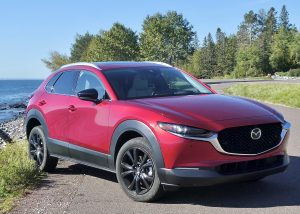
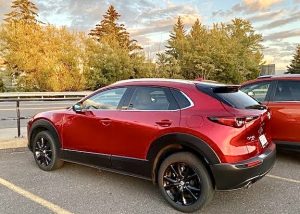
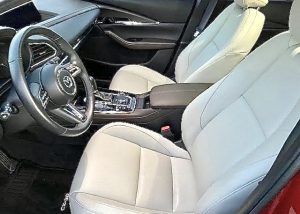

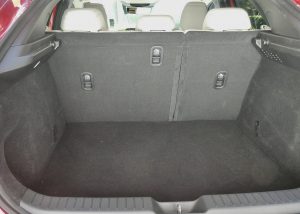
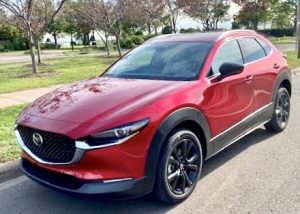
 John Gilbert is a lifetime Minnesotan and career journalist, specializing in cars and sports during and since spending 30 years at the Minneapolis Tribune, now the Star Tribune. More recently, he has continued translating the high-tech world of autos and sharing his passionate insights as a freelance writer/photographer/broadcaster. A member of the prestigious North American Car and Truck of the Year jury since 1993. John can be heard Monday-Friday from 9-11am on 610 KDAL(www.kdal610.com) on the "John Gilbert Show," and writes a column in the Duluth Reader.
John Gilbert is a lifetime Minnesotan and career journalist, specializing in cars and sports during and since spending 30 years at the Minneapolis Tribune, now the Star Tribune. More recently, he has continued translating the high-tech world of autos and sharing his passionate insights as a freelance writer/photographer/broadcaster. A member of the prestigious North American Car and Truck of the Year jury since 1993. John can be heard Monday-Friday from 9-11am on 610 KDAL(www.kdal610.com) on the "John Gilbert Show," and writes a column in the Duluth Reader.